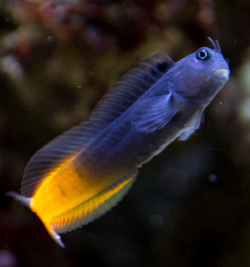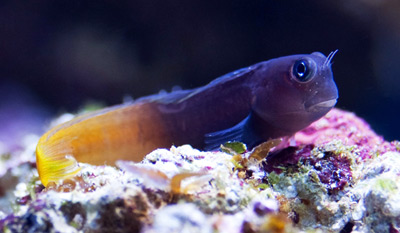Included in the Indo-Pacific genus Ecsenius are several interesting, beginner-friendly, generally aquarium-worthy blennies, among them the popular bicolor blenny (E. bicolor). This species’ modest size and bottom-dwelling habit also make it a great choice for smaller aquarium systems.
Physical traits
Though by no means brightly colored, E. bicolor is attractive nonetheless. Actually, there are several color phases of this species, but the one you’re most likely to encounter has a bluish/purplish/brownish anterior (emphasis on “ish,” as characterizing this species’ color is not as straightforward as it might seem) giving way to an orangish-yellow posterior.
Its body is slender and almost eel-like, and it has a long, continuous dorsal fin; blunt head; high-set, bulbous eyes; and antennae-like cirri protruding from between the eyes. Its maximum length is approximately 4 inches. At the risk of anthropomorphizing this species, it can, perhaps, best be described as both droll and beguiling.
Housing

As mentioned, E. bicolor is a small benthic species—typically found perched on the rockwork or hopping from rock to rock, intently rasping algae as it moves along. Therefore, it doesn’t demand a great deal of open swimming space. I’d put its minimum aquarium size at around 30 gallons. This species will typically choose a hole in the rockwork as its regular refuge, so be sure to provide a good amount of porous, holey live rock. Also, note that it’s best to introduce E. bicolor to a mature aquarium with a decent crop of microalgae to graze rather than a “sterile,” newly set up system.
Feeding
E. bicolor is predominantly herbivorous, so in addition to providing grazing opportunities (natural microalgae growth) in the tank, a good mix of green foods, including various algae-based dried foods (e.g., New Life Spectrum® AlgaeMax pellets) and frozen herbivore formulations, should be offered.
Compatibility
The bicolor blenny is relatively peaceful, though it may squabble with perceived resource competitors, such as other blennies or species that are very similar in appearance or habits. Conspecifics are also best avoided unless you can be certain of acquiring a bonded pair.
It’s generally safe to keep E. bicolor in reef systems, but do keep in mind that, as is often the case with herbivorous species, it may nip at fleshy coral polyps and tridacnid clam mantles as it grazes over the rocks and substrate, causing them to retract their tissues, potentially with adverse health effects if the behavior persists.



